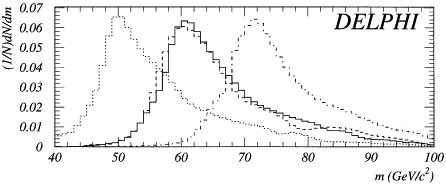If the two histograms in the example in the article (see Fig.1) are hist60 and hist70, representing the invariant mass distributions of a hypothetical particle with mass 60 or 70 GeV, respectively, then the interpolated histogram hist65 may be created with:
TH1F *hist65 = (TH1F *)th1morph("hist65","Interpolation to 65 GeV",hist60,hist70,60,70,65);
Some examples, in the form of simple animations, serve to illustrate the successful interpolation between 2 Gaussian distributions (execute the root macro gausfilm.C) and between 2 exponential distributions (execute the root macro expfilm.C). The examples assume you have previously downloaded th1fmorph.C .
One should always test the interpolation by comparison of an interpolated histogram to a regular histogram (say you have parameter-ordered histograms A, B, C - compare the interpolation between A and C at the value of the parameter to which B corresponds to B itself and check that it makes sense).
To illustrate the limitations of the method, an amusing failure to interpolate between 2 Gaussian distributions on top of a large, exponential background is provided (execute the root macro bumpfilm.C).
The beginning of the macro documents the arguments in some more detail:
TH1F *th1fmorph(Char_t *chname="TH1F-interpolated",
Char_t *chtitle="Interpolated histogram",
TH1F *hist1,TH1F *hist2,
Double_t par1,Double_t par2,Double_t parinterp,
Double_t morphedhistnorm=1,
Int_t idebug=1)
{
//--------------------------------------------------------------------------
// Author : Alex Read
// Version 0.1 of ROOT implementation, 05.05.2011
// *
// * Perform a linear interpolation between two histograms as a function
// * of the characteristic parameter of the distribution.
// *
// * The algorithm is described in Read, A. L., "Linear Interpolation
// * of Histograms", NIM A 425 (1999) 357-360.
// *
// * This ROOT-based CINT implementation is based on the FORTRAN77
// * implementation used by the DELPHI experiment at LEP (d_pvmorph.f).
// * The use of double precision allows pdf's to be accurately
// * interpolated down to something like 10**-15.
// *
// * The input histograms don't have to be identical, the binning is also
// * interpolated.
// *
// * Extrapolation is allowed (a warning is given) but the extrapolation
// * is not as well-defined as the interpolation and the results should
// * be used with great care.
// *
// * Data in the underflow and overflow bins are completely ignored.
// * They are neither interpolated nor do they contribute to the
// * normalization of the histograms.
// *
// * Input arguments:
// * ================
// * chname, chtitle : The ROOT name and title of the interpolated histogram.
// * Defaults for the name and title are "THF1-interpolated"
// * and "Interpolated histogram", respectively.
// *
// * hist1, hist2 : The two input histograms.
// *
// * par1,par2 : The values of the linear parameter that characterises
// * the histograms (e.g. a particle mass).
// *
// * parinterp : The value of the linear parameter we wish to
// * interpolate to.
// *
// * morphedhistnorm : The normalization of the interpolated histogram
// * (default is 1.0).
// *
// * idebug : Default is zero, no internal information displayed.
// * Values between 1 and increase the verbosity of
// * informational output which may prove helpful to
// * understand errors and pathalogical results.
// *
// * The routine returns a pointer (TH1F *) to a new histogram which is
// * the interpolated result.
// *
// *------------------------------------------------------------------------
